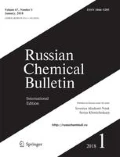Summary
-
1.
A study was made of the hydrolysis of adipoyl, sebacoyl, isophthaloyl, and terephthaloyl chlorides under the conditions of interphase polycondensation.
-
2.
The amount of acid chloride hydrolyzed increases with increase in reaction time, but the rate of hydrolysis gradually falls.
-
3.
The rate of the hydrolysis of the dicarboxylic acid chlorides investigated increases with rise in reaction temperature and alkali concentration.
-
4.
The tendency for the investigated dicarboxylic acid chloride to hydrolyze diminishes in the following order: adipoyl chloride, sebacoyl chloride, isophthaloyl chloride, terephthaloyl chloride.
Similar content being viewed by others
Literature cited
P. W. Morgan, SPEJ.,15, 485 (1959).
T. M. Frunze, V. V. Kurashev, and L. V. Kozlov, Uspekhi khimii,30, 593 (1961).
V. V. Korshak, T. M. Frunze, S. V. Vinogradova, V. V. Kurashev, and A. S. Lebedeva, Vysokomolek. soed.,3, 371 (1961).
V. V. Korshak, S. V. Vinogradova, T. M. Frunze, A. S. Lebedeva, and V. V. Kurashev, Vysokomolek. soed.,3. 984 (1961).
Author information
Authors and Affiliations
Rights and permissions
About this article
Cite this article
Korshak, V.V., Frunze, T.M., Vinogradova, S.V. et al. Significance of the hydrolysis of some aliphatic and aromatic dicarboxylic acid chlorides in interphase polycondensation. Russ Chem Bull 11, 1714–1719 (1962). https://doi.org/10.1007/BF00920266
Received:
Issue Date:
DOI: https://doi.org/10.1007/BF00920266


